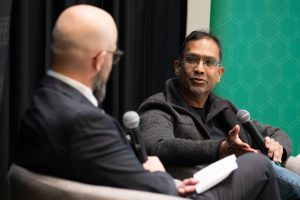By Michael Bussière
You may remember Larry O’Brien as the mayor who dared Ottawa to embrace its swagger.
He’s a man with plenty of swagger himself and one who always seems to be ahead of his time. Ottawa-born and raised, O’Brien started as a physics technologist in the 1970s, when local high-tech was in its infancy. His work in semiconductor design and secure radio communications led him to jump into business for himself.
(Sponsored)

Desjardins Elevator Pitch Competition drives entrepreneurial energy at uOttawa
In uOttawa’s Desjardins Elevator Pitch Competition, a single team member stands before the judges, pitching for three minutes, fielding questions for five. There are no decks, notes, props or prototypes

Advertising or posting a job opportunity is about to get more complicated for many local organizations with 25 or more employees. That’s because of a slew of updates to Ontario’s
“When I started my first company in 1979, I made every mistake possible and I think I somehow even managed to make mistakes that were almost impossible to make,” O’Brien recalled in a recent interview with OBJ. “But I tell you, it taught me I wasn’t as smart as I thought, so I took a couple of years, checked my ego at the door, and regrouped.”
In 1982, O’Brien was the protagonist in that classic success story of a man with an idea and a few bucks in his pocket. That one-person startup was his second company. Ten years later, it went public. Today, it is known as Calian Group, a multi-faceted provider of health-care and IT services, training and advanced technology with more than 4,500 employees and a current market capitalization of $550 million.
“I started with $35, and if I’d known where it was going I would have borrowed another $35,” O’Brien jokes.
Calian put O’Brien among Terry Matthews, Michael Cowpland and others during a time of great promise and excitement in the local tech scene.
“We really did think we were Silicon Valley North, right up until the time that Nortel collapsed, which was a huge loss,” O’Brien says. “Mike and Terry came out of that company. So much was happening in those years.”
Back in 1971, O’Brien recalls, there were only about 10 technology companies and government agencies in Ottawa.
“When I started, tech employed maybe 1,500 people. I think the peak was in 1996, when there were hundreds of companies that employed fifty to sixty thousand people. You can imagine how thrilling it was.”
In 2006, O’Brien left Calian as CEO but continued serving on the board. He had his sights set on that year’s municipal election and made a bold move by skipping over the usual first step of a council seat and running as a rookie mayor. Earlier that year, O’Brien was named the United Way’s Community Builder of the Year.
Clash of styles at city hall
But it wasn’t long before his CEO style collided with what he viewed as a rather pedestrian management culture at city hall. Nevertheless, O’Brien believes he got results.
He points to the Lansdowne Park redevelopment as an example of a huge improvement to a major city asset during his tenure. Additionally, O’Brien insisted on a re-evaluation of what he considered a flawed strategy for introducing light rail to the capital. This resulted in a total reboot, the effects of which are still being felt today.
O’Brien’s political and tech/entrepreneurial careers converged in 2021 into Prior Arts (PriorArts.io), a think tank mandated to “explore ways to improve the world through the application of blockchain technologies.”
He proposed a new vision for democracy in a white paper presented at the 2022 Blockchain Futurist Conference in Toronto. The paper addresses what he describes as an outmoded system that originated in the 17th century by proposing a 21st-century modernization that combines direct, technology-enabled participation with representative government.
“DGOV3 (Digital Governance 3) is based on my personal experience of democracy’s evolution,” O’Brien explains. “To re-engage people, elected representatives could propose ideas vetted by the administration or AI that are then sent out to the public in a secure blockchain format for decision-making. It won’t happen for another 20, 30 or 40 years, but it’s inevitable.” The paper is available on the Prior Arts website.
Most recently, O’Brien’s tech-visionary imagination inspired him to pursue fiction writing, and it is no surprise he was drawn to sci-fi and the theme of artificial intelligence. He considers this to be career No. 4.
His novel 2028 — Tomorrow is the Day begins with the uncovering of a mysterious alien artifact in the vastness of the Canadian Arctic. Two exceptional siblings, Ray and Deanna Stone, are “placed at the centre of humanity’s most significant crisis: a conflict involving technology and force with an alien AI. United by blood but separated by destiny, they find themselves on opposing sides of a conflict that has the potential to bring about the end of human existence.”
A direct line can be drawn from O’Brien’s early years in technology to the themes he explores in his book.
“My first project when I graduated was with a Northern Telecom (Nortel) subsidiary assisting with second sourcing for a brand-new memory chip that could store 1,000 bytes of information from a small startup California company called Intel. Now we’re at the inception of AI on a large scale,” he says.
“Humankind just keeps on moving forward. So, how do we direct that in a positive way? I’ve tried to write a story that has a positive outcome, but it’s not without a struggle.”
The book also reflects O’Brien’s experiences in northern Quebec, learning firsthand about the struggles facing Inuit communities. Alien AI, he imagines, would have the same impact on humanity as contact with Europeans had on the Inuit.
O’Brien concedes that writing a novel was the most challenging thing he has ever done. “I have had an incredible life journey,” O’Brien said, “and I have always tried to influence the world around me positively.”
2028 — Tomorrow is the Day is due for release Oct. 11.





